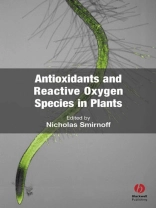Reactive oxygen species (ROS) are produced during the interaction of metabolism with oxygen. As ROS have the potential to cause oxidative damage by reacting with biomolecules, research on ROS has concentrated on the oxidative damage that results from exposure to environmental stresses and on the role of ROS in defence against pathogens. However, more recently, it has become apparent that ROS also have important roles as signalling molecules. A complex network of enzymatic and small molecule antioxidants controls the concentration of ROS and repairs oxidative damage, and research is revealing the complex and subtle interplay between ROS and antioxidants in controlling plant growth, development and response to the environment.
This book covers these new developments, generally focussing on molecular and biochemical details and providing a point of entry to the detailed literature. It is directed at researchers and professionals in plant molecular biology, biochemistry and cell biology, in both the academic and industrial sectors.
Inhaltsverzeichnis
1. Glutathione.
Christine H. Foyer, Leonardo Gomez and Philippus D. R. van
Heerden, Rothamsted Research, Harpenden, UK.
2. Plant thiol enzymes and thiol homeostasis in relation to
thiol-dependent redox regulation and oxidative stress.
Karl-Josef Dietz, Lehrstuhl für Biochemie und Physiologie
der Pflanzen, Fakultät für Biologie, Universität
Bielefeld, Germany.
3. Ascorbate, tocopherol and carotenoids: metabolism, pathway
engineering and functions.
Nicholas Smirnoff, School of Biological and Chemical Sciences,
University of Exeter, UK.
4. Ascorbate peroxidase.
Ron Mittler, Department of Biochemistry, University of Nevada,
Reno, USA and Thomas L. Poulos, Department of Molecular Biology and
Biochemistry, University of California, Irvine, USA.
5. Catalases in plants: molecular and functional properties and
role in stress defence.
Jürgen Feierabend, Institute of Botany, J. W. Goethe
Universität, Frankfurt, Germany.
6. Phenolics as antioxidants.
Stepehen C. Grace, Biology Department, University of Arkansas at
Little Rock, Arkansas, USA.
7. Reactive oxygen species as signalling molecules.
Radhika Desikan, John Hancock and Steven Neill, Centre for
Research in Plant Science, University of the West of England,
Bristol, UK.
8. Reactive oxygen species in plant development and pathogen
defence.
Mark A. Jones and Nicholas Smirnoff, School of Biological and
Chemical Sciences, University of Exeter, UK.
9. Reactive oxygen species in cell walls.
Robert A. M. Vreeburg and Stephen C. Fry, School of Biological
Sciences, University of Edinburgh, UK.
10. Reactive oxygen species and photosynthesis.
Barry Logan, Biology Department, Bowdoin College, Brunswick,
Maine, USA.
11. Plant responses to ozone.
Pinja Jaspers, Hannes Kollist, Christian Langebartels, and
Jaakko Kangasjärvi, Department of Biological and Environmental
Sciences, University of Helsinki, Finland.
References.
Index
Über den Autor
Dr Nicholas Smirnoff is at the School of Biological and Chemical Sciences, University of Exeter, UK












